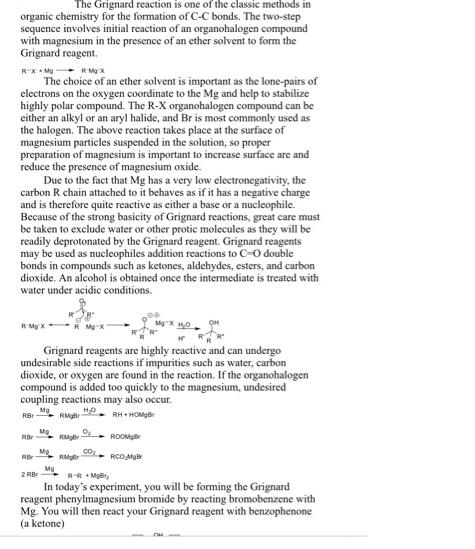Answered step by step
Verified Expert Solution
Question
1 Approved Answer
The Grignard reaction is one of the classic methods in organic chemistry for the formation of C-C bonds. The two-step sequence involves initial reaction




The Grignard reaction is one of the classic methods in organic chemistry for the formation of C-C bonds. The two-step sequence involves initial reaction of an organohalogen compound with magnesium in the presence of an ether solvent to form the Grignard reagent. - RMyX R-X Mo The choice of an ether solvent is important as the lone-pairs of electrons on the oxygen coordinate to the Mg and help to stabilize highly polar compound. The R-X organohalogen compound can be either an alkyl or an aryl halide, and Br is most commonly used as the halogen. The above reaction takes place at the surface of magnesium particles suspended in the solution, so proper preparation of magnesium is important to increase surface are and reduce the presence of magnesium oxide. Due to the fact that Mg has a very low electronegativity, the carbon R chain attached to it behaves as if it has a negative charge and is therefore quite reactive as either a base or a nucleophile. Because of the strong basicity of Grignard reactions, great care must be taken to exclude water or other protic molecules as they will be readily deprotonated by the Grignard reagent. Grignard reagents may be used as nucleophiles addition reactions to C-O double bonds in compounds such as ketones, aldehydes, esters, and carbon dioxide. An alcohol is obtained once the intermediate is treated with water under acidie conditions. RMX R My Grignard reagents are highly reactive and can undergo undesirable side reactions if impurities such as water, carbon dioxide, or oxygen are found in the reaction. If the organohalogen compound is added too quickly to the magnesium, undesired coupling reactions may also occur. Mg RMyBr RH HOMgB RBr Mg RBr ROOM Mg RBr co RCOMyb Mg 2 RBr R-R MgBr, In today's experiment, you will be forming the Grignard reagent phenylmagnesium bromide by reacting bromobenzene with Mg. You will then react your Grignard reagent with benzophenone (a ketone) 1. P 2 HO beruophenone phenymethanal A significant factor of today's lab is that you will be responsible for planning out your reaction and determining the amounts of the starting materials to use. All students will be running the reaction using 0.015 moles of their starting carbonyl compound and a slight excess of the Grignard reagent. You will form your Grignard reagent using 1.25 molar equivalents of the bromobenzene (relative to the benzophenone) and 1.35 molar equivalents of magnesium. You will also need to determine the best way to measure out the reagents depending on whether they are solids or liquids at room temperature. Reading Assignment: From Essential Organic Chemistry, 2" edition, by Paula Bruice "Grignard reactions" pp. 328-330. From Techniques in Organic Chemistry, 4" edition, by Mohrig, et al. "Anhydrous Reaction Conditions" pp. 90-93. Procedure: Preparation of phenylmagnesium bromide 1. Set up a reaction apparatus starting with a 100-ml round-bottom flask (with stir-bar) and Claisen adapter. Place the separatory funnel on the joint of the Claisen adapter directly above the flask. Use the straight-tube adapter and thermometer adapter to attach a drying tube to the top of the separatory funnel. Attach a reflux condenser to the second arm of the Claisen adapter. Place a small ball of cotton in the top joint of the reflux condenser. The apparatus should be clamped at the Claisen adapter and the reflux condenser. Use a Keck clip to attach the round-bottom flask to the Claisen condenser. The entire set-up should be placed above a stir-plate. Sufficient room should be left between the stir-plate and the reaction apparatus that a beaker of water may be placed under the flask if needed. Use a heat gun to thoroughly dry the reaction apparatus, but be careful not to melt any of the plastic parts. 2. Remove the round-bottom flask from the set-up and add magnesium turnings which have been freshly ground in a mortar and pestle or buffed with sandpaper. Also add 5 ml of anhydrous ethyl ether and 2-3 drops of 1,2-dibromoethane (which helps to facilitate the formation of the Grignard reagent). Return the flask to the set-up. 1. Draw your complete reaction, including the formation of the Grignard reagent and the reaction with your carbonyl compound. Below each reagent, write its molecular weight and density (if a liquid). Also write how much of each material you will use in mL (if liquid), grams, and moles. Also include the molecular weight and melting point of your final product. OH 2. How many moles of Grignard reagent are you synthesizing? What mass of water could fully react with that amount of Grignard reagent? What volume of water would that be? 3. Step 11 of the procedure is called trituration and is used to extract any nonpolar impurities from your crude product (petroleum ether is a mixture of different isomers of pentanes, hexanes, and heptanes). Considering the possible side reactions that can occur, draw the structure of the likely non-polar side product that you are removing in this step?
Step by Step Solution
★★★★★
3.44 Rating (160 Votes )
There are 3 Steps involved in it
Step: 1
Step1 Dry THF Br MgBr Mg bromobenzene Step2 OH MgBr 2 HH2O diphenylmethanone triphenylmethanol 1 We ...
Get Instant Access to Expert-Tailored Solutions
See step-by-step solutions with expert insights and AI powered tools for academic success
Step: 2

Step: 3

Ace Your Homework with AI
Get the answers you need in no time with our AI-driven, step-by-step assistance
Get Started


